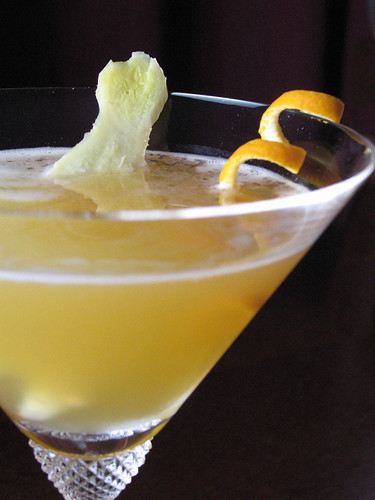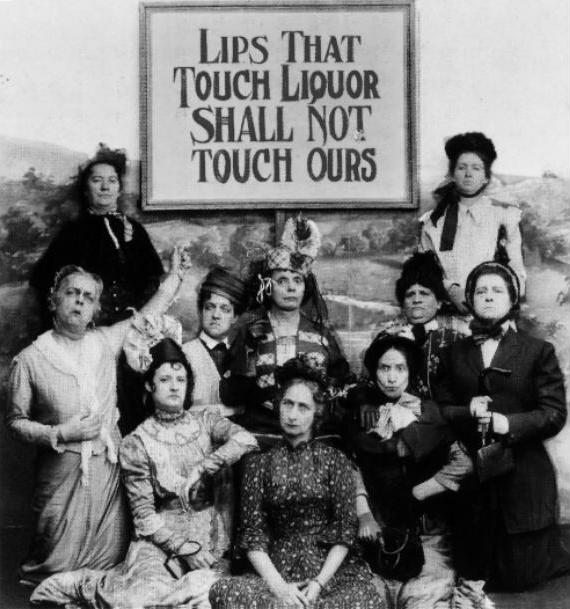Well! I actually managed to do some experimentation and alchemy this weekend, and a post as well. This month’s Mixology Monday is being hosted by Craig Hermann at Tiki Drinks & Indigo Firmaments, and the theme is described thusly:
 Spice should give you plenty of room to play – from the winter warmers of egg nog, wassail and mulled products to the strange and interesting infusions of pepper, ceubub, grains of paradise, nutmeg — what have you! I would like to stretch the traditional meanings of spice (as the bark, seed, nut or flowering part of a plant used for seasoning) to basically anything used for flavoring that isn’t an herb. Salt? Go for it. Paprika? I’d love to see you try. I hear that cardamom is hot right now.
Spice should give you plenty of room to play – from the winter warmers of egg nog, wassail and mulled products to the strange and interesting infusions of pepper, ceubub, grains of paradise, nutmeg — what have you! I would like to stretch the traditional meanings of spice (as the bark, seed, nut or flowering part of a plant used for seasoning) to basically anything used for flavoring that isn’t an herb. Salt? Go for it. Paprika? I’d love to see you try. I hear that cardamom is hot right now.
Perfect timing. I turned to the row of tinctures I’ve been working on.
For those readers who might not be cocktail geeks (or chemists), a tincture is defined as an alcoholic extract or solution of a non-volatile substance. In medicine it’s generally an herb or other organic substance (even a drug) used for medicinal purposes. Audrey Saunders of The Pegu Club in New York has been on the forefront of using tinctures as liquid spice to flavor cocktails, and many other folks have been using them to create customized batches of bitters. I’ve been experimenting with both of late.
I want to build up a base supply of tinctures not only for experimentation but also to make bitters, rather than infusing herbs and spices directly into the base spirit (quicker results this way). I’ve got qutie a few so far, and I’ve still got a few batches brewing with more on the way. Unless noted, each tincture is made with 80 proof vodka, in four-ounce quantities. I fill the jar between 1/3 and 1/2 full with the herb or spice, and spices are generally toasted briefly in a skillet to bring out the volatile oils and flavors. I add four ounces of vodka (or whatever other spirit I may wish to use), and give it about 3 weeks of steeping with occasional (daily) agitating. My spices are almost all obtained from Penzey’s, who offer high quality and low cost, plus a few others (like bittering agents) from herbalists like Tenzing Momo.
Here’s what I’ve got so far: Cinnamon (in 126-proof Wray & Nephew Overproof Rum), Cardamom, Clove, Nutmeg, Lavender, Ginger, Star Anise, and Szechuan Peppercorn.
My bitters blending experiment is still a ways off, and I wanted to do something more than just seasoning a cocktail today. (That said, the cinnamon tincture, which is marvelously flavorful on its own and has a wonderful bitterness from the tannins in the bark, is great in a Manhattan, Old Fashioned or Jeffrey Morgenthaler’s Autumn Leaves cocktail, and the lavender tincture lovely in a Martini, and more suggestions to come the more I play with them.) I wanted to showcase one of them, and I wanted to do something original.
The one I wanted to work wtih the most, and to the best of my knowledge one that has yet to be explored in cocktails (and please correct me if I’m wrong), is Szechuan peppercorn.

Szechuan peppercorns (public domain image via Wikipedia)
It’s an amazing spice. You’re probably more familiar with it than you think, as it’s one of the ingredients in Chinese Five-Spice Powder. (You may recall I’ve been having fun playing with Scott Beattie’s five-spice syrup over the last few weeks.) It’s not related to the black peppercorn with which we’re all famliar (Piper nigrum) but from an entirely different genus (Zanthoxylum piperitum), and is called 花椒 or huājiāo in Mandarin (“flower pepper”).
Now, for the flavor. If you’ve ever crunched up a few Szechuan peppercorns in your mouth, the first thing you get is a very aromatic quality, with a lemony, earthy, slightly smoky, spicy-hot but not overwhelmingly so, not burning yoru mouth at all, but with more of the aromatic quality you might think of in black pepper without the same kind of flavor or bite, but with its own bite — so very much going on! And then … you start to get the tingle.
The Chinese call it 麻辣, málà, or “numbing spicy.” You get a very pronounced tingling on your lips and tongue, followed by a bit of numbness but one that does not remove the flavor sensation. It lingers for about five minutes. It’s wild.
When you taste a drop of tincture of Szechaun peppercorn, you get all this and then some.
Now, what the frak do I do with it?
I began thinking of flavor affinities with the spice that I already knew about, and consulted my handy-dandy copy of The Flavor Bible  for more ideas. I was kind of pining for some kind of Asian spirit for a base — a really good, flavorful sake, or maybe soju? Then I started thinking outside the box and decided on Good Ol’ Bourbon.
for more ideas. I was kind of pining for some kind of Asian spirit for a base — a really good, flavorful sake, or maybe soju? Then I started thinking outside the box and decided on Good Ol’ Bourbon.
I knew I wanted ginger in there — ginger is one of the five spices in some versions of Chinese five-spice — and thought of accenting with star anise, another of those flavors, but decided spice-wise to stick with just the one. So, Bourbon, ginger, tincture … and then thought lime juice for balance. I chose Domaine de Canton Ginger Liqueur as the ginger flavor moderator.
The first iteration contained those four ingredients. Okay. Not bad. Something wasn’t right, though. Wes and I started thinking of other base spirits to try in lieu of sake or soju. Vodka was out. Rum? Hm, dunno, maybe. Gin? Hmm. Gin. It’s got its own base of botanicals that play well with others. Why not?
Iterations with gin … didn’t work. There was something harsh, glassy about it that neither of us liked. Back to Bourbon, and back to The Flavor Bible.
I think a bit of the harshness, and a tropicality that I didn’t really want, was coming from the lime juice. I wanted acid for balance, but maybe not so much acid. Orange was listed as one of the flavors with an affinity for Szechuan peppercorn, so I tried that.
Bingo.
The base spirit smoothed out such that you almost forgot it was Bourbon, but gave it a good, warm base for accepting and embracing the spice. The ginger was sharp yet mellow yet bright, the orange provided the perfect acid balance as well as a lovely flavor, and that spice, hoo-boy … so exotic! Someone drinking this might well be hard-pressed to identify what it was, and I love it when that happens. And the tingle? Maybe. Just a little bit. Way in the background, not enough to be distracting, maybe even not enough such that you’re really sure it’s there. You’re probably not sure.
Wes and I decided this one was a keeper, and I decided to name it for The God of Szechuan Cuisine — at least to those of us who are “Iron Chef” fans. (That’s the real “Iron Chef,” I mean.)

The Chen-san Cocktail
2 ounces Bourbon whiskey (I used Four Roses).
1/2 ounce Domaine de Canton Ginger Liqueur.
1/2 ounce freshly squeezed orange juice.
2-4 dashes tincture of Szechuan peppercorn, to taste (I used four dashes, or 40 drops).
Combine with ice in a shaker and shake like hell for 12-15 seconds. Strain into a chilled cocktail glass. Garnish with a thin slice of fresh ginger and a curly orange twist.
This stuff’s going to be fun to play with. I’ve got a batch of bitters in mind next.

 Spice should give you plenty of room to play – from the winter warmers of egg nog, wassail and mulled products to the strange and interesting infusions of pepper, ceubub, grains of paradise, nutmeg — what have you! I would like to stretch the traditional meanings of spice (as the bark, seed, nut or flowering part of a plant used for seasoning) to basically anything used for flavoring that isn’t an herb. Salt? Go for it. Paprika? I’d love to see you try. I hear that cardamom is hot right now.
Spice should give you plenty of room to play – from the winter warmers of egg nog, wassail and mulled products to the strange and interesting infusions of pepper, ceubub, grains of paradise, nutmeg — what have you! I would like to stretch the traditional meanings of spice (as the bark, seed, nut or flowering part of a plant used for seasoning) to basically anything used for flavoring that isn’t an herb. Salt? Go for it. Paprika? I’d love to see you try. I hear that cardamom is hot right now.






